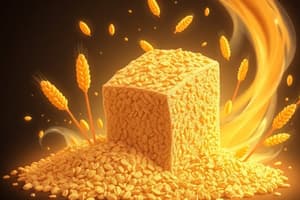Podcast
Questions and Answers
What is the primary reason why polypeptides of gluten have little folded structure?
What is the primary reason why polypeptides of gluten have little folded structure?
- They are rich in proline (correct)
- They are rich in hydroxyl groups
- They are rich in sulfhydryl groups
- They are rich in amide groups
What is the effect of adding whey proteins and soy proteins to wheat flour on the viscoelastic properties of the dough?
What is the effect of adding whey proteins and soy proteins to wheat flour on the viscoelastic properties of the dough?
- Has no effect on the viscoelastic properties
- Decreases the viscoelastic properties (correct)
- Alters the pH of the dough
- Increases the viscoelastic properties
What is the purpose of adding phospholipids or surfactants to dough?
What is the purpose of adding phospholipids or surfactants to dough?
- To decrease the water content of the dough
- To counter the adverse effects of foreign proteins on loaf volume (correct)
- To increase the protein content of the dough
- To alter the pH of the dough
What is the result of combining isolated gluten with comminuted meat and surimitype products?
What is the result of combining isolated gluten with comminuted meat and surimitype products?
What is the effect of mixing and kneading on the folded structure of gliadins and glutenins?
What is the effect of mixing and kneading on the folded structure of gliadins and glutenins?
Why does the addition of albumin- and globulin-type proteins decrease bread volume?
Why does the addition of albumin- and globulin-type proteins decrease bread volume?
What is the main reason why supplementation of wheat flour with certain proteins adversely affects the viscoelastic properties of the dough?
What is the main reason why supplementation of wheat flour with certain proteins adversely affects the viscoelastic properties of the dough?
What is the role of sulfhydryl-disulfide interchange reactions in wheat dough?
What is the role of sulfhydryl-disulfide interchange reactions in wheat dough?
What happens to the folded structure of gliadins and glutenins during baking?
What happens to the folded structure of gliadins and glutenins during baking?
What is the result of adding phospholipids or surfactants to dough containing foreign proteins?
What is the result of adding phospholipids or surfactants to dough containing foreign proteins?
Why is isolated gluten used as a protein ingredient in non-bakery products?
Why is isolated gluten used as a protein ingredient in non-bakery products?
What is the primary structural property of polypeptides of gluten that affects their function?
What is the primary structural property of polypeptides of gluten that affects their function?
Study Notes
Factors Affecting Viscoelastic Properties of Wheat Dough
- Hydrogen bonding among amide and hydroxyl groups, hydrophobic interactions, and sulfhydryl-disulfide interchange reactions contribute to the development of unique viscoelastic properties.
- The culmination of these interactions into good dough-making properties depends on the structural properties of each protein and their associations in the overall gluten structure.
Protein Structure in Gluten
- Polypeptides of gluten, especially glutenins, are rich in proline, resulting in very little folded structure.
- Whatever folded structure initially exists in gliadins and glutenins is lost during mixing and kneading, and no additional unfolding occurs during baking.
Effects of Supplementation on Dough Properties
- Supplementation of wheat flour with albumin- and globulin-type proteins (e.g., whey proteins and soy proteins) adversely affects viscoelastic properties and baking quality of the dough.
- These proteins decrease bread volume by interfering with formation of the gluten network.
Counteracting Adverse Effects with Surfactants
- Addition of phospholipids or other surfactants to dough counters the adverse effects of foreign proteins on loaf volume.
- The surfactant/protein film compensates for the impaired gluten film, resulting in acceptable loaf volume.
Textural and Sensory Qualities of Bread
- Although surfactants can restore loaf volume, the textural and sensory qualities of the bread are less desirable than normal.
Isolated Gluten as a Protein Ingredient
- Isolated gluten is used as a protein ingredient in non-bakery products due to its cohesion-adhesion properties.
- It is an effective binder in comminuted meat and surimi-type products.
Factors Affecting Viscoelastic Properties of Wheat Dough
- Hydrogen bonding among amide and hydroxyl groups, hydrophobic interactions, and sulfhydryl-disulfide interchange reactions contribute to the development of unique viscoelastic properties.
- The culmination of these interactions into good dough-making properties depends on the structural properties of each protein and their associations in the overall gluten structure.
Protein Structure in Gluten
- Polypeptides of gluten, especially glutenins, are rich in proline, resulting in very little folded structure.
- Whatever folded structure initially exists in gliadins and glutenins is lost during mixing and kneading, and no additional unfolding occurs during baking.
Effects of Supplementation on Dough Properties
- Supplementation of wheat flour with albumin- and globulin-type proteins (e.g., whey proteins and soy proteins) adversely affects viscoelastic properties and baking quality of the dough.
- These proteins decrease bread volume by interfering with formation of the gluten network.
Counteracting Adverse Effects with Surfactants
- Addition of phospholipids or other surfactants to dough counters the adverse effects of foreign proteins on loaf volume.
- The surfactant/protein film compensates for the impaired gluten film, resulting in acceptable loaf volume.
Textural and Sensory Qualities of Bread
- Although surfactants can restore loaf volume, the textural and sensory qualities of the bread are less desirable than normal.
Isolated Gluten as a Protein Ingredient
- Isolated gluten is used as a protein ingredient in non-bakery products due to its cohesion-adhesion properties.
- It is an effective binder in comminuted meat and surimi-type products.
Studying That Suits You
Use AI to generate personalized quizzes and flashcards to suit your learning preferences.
Description
This quiz explores the role of hydrogen bonding, hydrophobic interactions, and sulfhydryl-disulfide interchange reactions in the development of wheat dough's viscoelastic properties. It also delves into the structural properties of gluten proteins and their associations.




